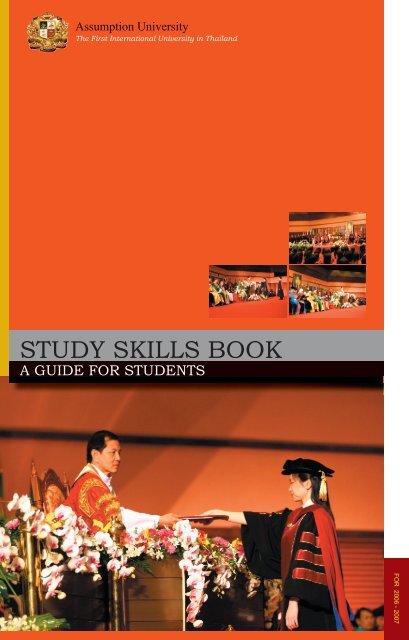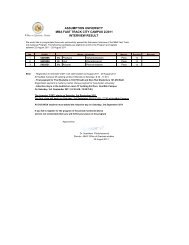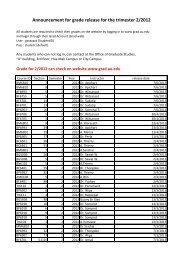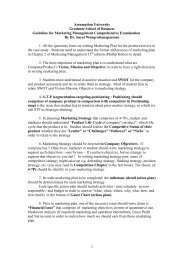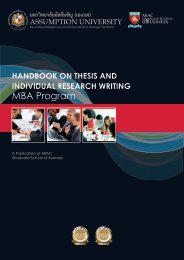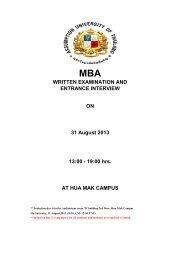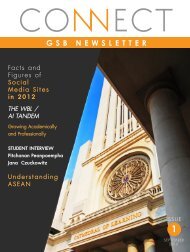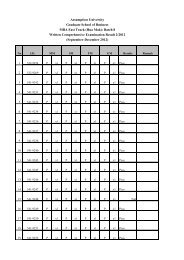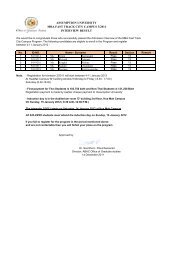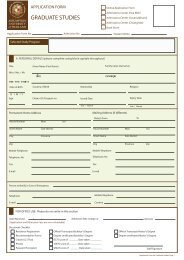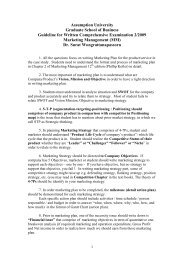STUDY SKILLS BOOK - Assumption University
STUDY SKILLS BOOK - Assumption University
STUDY SKILLS BOOK - Assumption University
- No tags were found...
Create successful ePaper yourself
Turn your PDF publications into a flip-book with our unique Google optimized e-Paper software.
FORWARDMESSAGE FROMTHE DEANDear StudentsIt is our pleasure to welcome you to study at <strong>Assumption</strong> <strong>University</strong>,a great international university that is widely recognised asone of the most creative and influential in Thailand.This 2006 edition of the Study Skills Guide, has been designed tohelp students at all stages of their academic career and at differentlevels of experience. However good your study skills, there is usuallyroom for improvement! You may find yourself asked to use thisguide during short or long study skills sessions organized by yourinstructors, or you may just read it on your own.We suggest that you have a quick look through all of it now tofamiliarise yourself with the skills that it covers. Then, when youneed advice on the different skills, you can keep coming back toit. Don’t leave this guide under your bed to gather fluff, keep itsomewhere safe so that you can return to it during your study at<strong>Assumption</strong> <strong>University</strong>.Yours Sincerely,Dr. Kitti PhothikittiDean, ABAC Graduate SchoolDirector, Office of Graduate Studies<strong>STUDY</strong> <strong>SKILLS</strong> <strong>BOOK</strong> A GUIDE FOR STUDENTS 4
ORGANISING YOUR <strong>STUDY</strong>Before starting a study period allow for a warming up period anddo not expect to achieve a high level of efficiency as soon as youbegin. At the start and end of each period of work, review whatyou have done. Close your books and tell yourself the main pointsof the topic you have just been studying. When you come back tothis topic do another brief review before you start. 6 a. Give eachsubject equal time: do not neglect your “best” subject nor avoidyour “worst” b. As far as possible, plan each period of learning toreinforce the next; consider which topic will best follow on from theone you’ve been studying. c. Plan to study a particular subject assoon as possible after the lectures on it. Material is rememberedbetter if some attempt is made to recall it soon after its originalpresentation. d. Do you prefer to finish one task at a time or spendseveral short periods on each task? It is sensible to break up largeassignments into a series of more manageable smaller tasks. e.Some of your most valuable work may be done in consultation orconversation with your fellow students. Talking is a very good wayto develop and clarify your ideas.IMPROVING YOUR READING<strong>SKILLS</strong>Research suggests that the following ideas should be used to helpdevelop a reading strategy: 1. Make your reading an active process.The first thing to do is to skim over what you are going to readand get a general idea of what it is about. Look at the index, contents,chapter sub-headings and any summaries. Then set somequestions which you think this reading will help you answer. 2. Thebrain remembers best that which comes at the start and end of areading session so small, concentrated bursts of about 20 minutesreading, followed by a short break and then a review, are far moreeffective that reading marathons. 3. Don’t start taking detailednotes on the first few lines. Read the text purposefully, for mainideas and supporting detail. Note briefly any personal comments,general conclusions or queries you have in the margin. 4. At theend of a chapter, section, or even a few pages, take a break andwrite some notes in your own words. Remember to keep a note ofthe source of these notes (for referencing your assignment). 5. Thebrain remembers outstanding, linked and multi-sensory informationbest. So use exaggeration, color, highlighting and images in yournote-making. Consider trying patterned notes and mind maps. 6.Efficient reading involves making sensible predictions about whatcomes next in the text, using a minimum of clues. You don’t needto read every word. Try to fix on a key and sweep your eyes overabout three words on either side: only go quickly backwards if youneed to confirm or check your predictions. 7. Ideally you should try<strong>STUDY</strong> <strong>SKILLS</strong> <strong>BOOK</strong> A GUIDE FOR STUDENTS 7
NOTE TAKINGWe learn from many different source: textbooks, lectures, papers,handouts, formal and informal discussions. Integration from allthese sources is difficult. Acquiring the skill to bring it all togetheris probably one of the most important things you can do in orderto study successfully. Taking good notes at lectures is particularlyimportant. With other information sources you can usually go backto the original material to check, but at the end of a lecture onlyyour memory and your notes remain.There is no one “Best” style of taking notes in a lecture. The bestmethod will vary with your preferences, the lecture topic, the natureof handouts or visual material presented, and with the lecture’sstyle of presentation. In general, the lecturer aims to getacross three main types of information.Facts:All lectures contain factual material to be written down or copied.Concepts:Most lectures contain an element of conceptual integration of thematerial which may in fact be the moat important part of the lecture.Many lecturers concentrate on concepts, knowing that thebare facts can be found in texts.References:Sources of further relevant material may be given.The second category, concepts, usually present the most problems.Facts can be written down as they are presented, often inthe same form, as can further references. But concepts requireyou to contribute something by actively interpreting and displayingrelationships in a way that will aid recall. It can be difficult to recordconcepts and something a diagrammatic presentation (patternednotes or a mind map) can help as it is quick And more easily alteredif later developments in the lecture prompt a better concept.<strong>STUDY</strong> <strong>SKILLS</strong> <strong>BOOK</strong> A GUIDE FOR STUDENTS 11
11 A good set of notes should contain all the factual and referencematerial and be set out in such a way that the relationship betweenthem are clearly obvious. If the resulting notes also facilitates ‘inserting’other material at a later dates, so much the better. Thereare a number of ways of achieving this sort of result, the most commonof which are discussed here.Patterned Notes and Mind MapsIn Use your Head (London: BCC, 1974), Tony Buzan describes anapproach known as “brain-patterning” which almost amounts to arevolutionary approach for a student familiar only with conventionalor “linear” notes. To take such notes you should use unlined paperand colored pens. “Patterned” notes begin at the center of thepage and radiate out rather than beginning at the top and comingdown. The logic of the lecture is developed as a two dimensionalnetwork, with factual and reference material displayed in their appropriaterelationship to each other. This approach will eliminateproblems of order and logic, starting and ending sections, and organizationof data, all of which are taken care of within the patternitself. Patterned notes are open-ended, allowing for inserting ofextra material without destroying the logic. They aid recall in revisionperiods, sometimes of the extent that simply looking at thepage bring back the essential of the topic.Patterned notes can be used in note-taking from literature, andalso for planning written assignments or talks. Their most usefulproperty in such applications is their open-ended nature, whichpermits an argument to be structured, altered and elaborated uponwithout, at any stage, having to be scrapped in favor of a freshstart. If necessary, long lists or large section of new material can bedrawn elsewhere and indexed to the main pattern with referencenumber, or even via a long line from the opposite page to showwhere the new material “fits in”. Start by writing the topic in middleof the page and built up the logic from there. You will need to practicea few times before it comes easily. Try making your first mindmap of a TV news program rather than an important lecture! Thisapproach will not necessarily suit all students. You need to use theideas to develop a style which suits you and your needs.A SYSTEM FOR EFFECTIVELISTENING AND NOTE-TAKINGYou can think about 4 times faster than a lecturer can speak. Effectivelistening requires the expenditure of energy; to compensatefor the rate of presentation, you have to actively intend tolisten. Note-taking is one way to enhance listening, and using asystematic approach to the taking and reviewing of your notes canadd immeasurably to your understanding and remembering of thecontent of lectures.BEFORE CLASS• Develop a mind-set geared toward listening.• Test yourself over the previous lecture while waiting for<strong>STUDY</strong> <strong>SKILLS</strong> <strong>BOOK</strong> A GUIDE FOR STUDENTS 12
ESSAY WRITINGWriting essays and other assignments will be made easier if youlearn to break down this large task into smaller steps. Don’t think toyourself that you have an essay due in 5 weeks. Instead, plan eachstep along the way, setting yourself deadlines for the completionof each task and trying to keep to them. Plan your research andstart your reading and writing weeks, not days, before the essayis due. In fact, you should start thinking about your essay the momentyou are given the title. So, what are the steps in writingan essay?1. Some basics: Do you have to use particular sources?If so, locate them, is the essay a set length? Areyou sure of its due date? Are there any requirementsfor its presentation (does it have to be word processed?)2. Understand the question! Essay titles’ usually containone or more KEY WORDS, (such as analyze, contrast,define, discuss, evaluate, outline, and summarize) whichare your main guide as to what is required. Be sure thatyou note and understand these key words (there are manystudy skill books which define these and other key words intheir chapters on essay writing).3.Question the question itself. Brainstorm itspossibilities, scope and limitations. Defineeach term used in it and use these definitionsas tentative headings for your research. Essayquestion at university levels are usuallymore testing, more subtle and morecontroversially worded than those youhave confronted before. If you are unclearabout what is wanted, ask yourtutor for clarification.4.Plan your initial research aroundquestions relevant to the topic. Itis helpful to note ideas, facts, andquotes on separate cards. As youread and take notes keep on asking yourselfhow this material is going to fit in to your essay. Yoursubject may redefine itself as you become more familiarwith the material.5. Review all your material and make a rough outline plan whichyou will probably need to modify. Sort your ideas into a patternthat will best support the development of your ideas. This is a veryimportant part of your work. It is rarely sufficient to summarize material.You will be required to use techniques such as analyzing(detecting unstated assumptions, seeing interrelationships ideasor information in such a way as to build a pattern or structure notclearly there before), and evaluating (making judgement about<strong>STUDY</strong> <strong>SKILLS</strong> <strong>BOOK</strong> A GUIDE FOR STUDENTS 14
value of material and methodsfor given purpose).6. It is your responsibility, notyour reader’s, to see that youmake sense of your material.In most subjects no introductionoutlining the question andthe organization of your answer is necessary. In the same way, aconclusion that sums up and clinches your argument is necessary.Remember that side and sub-heading may be helpful in some subjects.a. Introductioni. Comment on the subject of the essay. (What do youunderstand by it? How is it important?) Explainany terms.ii. Introduce the points you are going to discuss.iii. Very briefly summerise the overall theme of your essay,indicating the main points to be made and the order inwhich they are to be presented. This gives the readeran idea of what to expect and rarely increasescomprehension. Do not waste your reader’s timewith padding.b. The Main Bodyi. Develop your line of argument through several mainideas. Each new idea should start with a new paragraph.ii. Support each idea with examples and illustrations drawnfrom the books, articles and any other sources youhave used.iii. As you develop your essay, make it clear how yourargument in one place relates to other points you haveused or will use.c. Conclusioni. Summarize the main idea.ii. Answer the question or comment on the topic.7. Heading can help to divide your text into logical units for bothyour reader and yourself. If you use headings, the text shouldmake sense as it stands. In other words, headings are additionalto the essay. Employ a conventional format in your setting-out ofheadings. The following format can be used where there are manysub-categories to be discussed.CENTRE HEADINGFREE STANDING SIDE HEADINGPARAGRAPH HEADING8. Be prepared to write more than one draft. Use a straightforward,basically simple, and grammatically accurate style. Do a first draftas rapidly as possible concentrating on content rather than style.Then re-check your material against the question.9. Beware of:a. oversimplifying issues-using jargon or cliches as asubstitute for careful explanation;b. making generalizations without giving specific examples;<strong>STUDY</strong> <strong>SKILLS</strong> <strong>BOOK</strong> A GUIDE FOR STUDENTS 15
c. using in appropriate analogies;d. quoting material that is irrelevant or out of context;e. adopting an emotive tone and writing in the firstperson (“I...”);f. using inconsistent approaches, and;g. making assertions without supporting evidence orargument.10. When you write:a. use complete, straightforward sentences, not notes;b. follow accepted English rules for spelling;c. avoid slang, colloquialisms and undue flourish andaffectation – this is formal work in which precision oflanguage is very important;d. make your punctuation accurate;e. use a good dictionary (e.g. concise Oxford) andthesaurus (e.g. Roget: Thesaurus of English wordsand phrases);f. check each paragraph for a topic sentence (which expresses the main idea of that paragraph) and for linkswith the preceding and following paragraphs;g. support your points with appropriate references andavoid plagiarism at all times;h. use quotations sparingly-paraphrase in your ownwords where possible;11. Your draft:After a day or two re-read your draft, preferably aloud and/or to acritical listener. The listener does not need to be an expert on thesubject. He can advise you on whether or not your essay is intelligiblewithout understanding every word. Be ruthless in your pruning,redrafting or even complete re-writing. Good work requires agreat deal of effort.12. Referencing & bibliographyUse references and bibliography to acknowledge your sources.Set these out according to scholarly conventions.13. Remember to consider your reader:a. Consult your lecturer about any special requirementsyour faculty may have.b. Use any spell or grammar check your word-processoroffers.c. Double-space or 1 space, when typing.d. Use lined paper when writing by hand and write legibly.e. Write on one side of paper only.f. Leave a generous margin for comments (4 to 5 cm)g. Staple pages togetherh. See that your name and subject title are on the paper.<strong>STUDY</strong> <strong>SKILLS</strong> <strong>BOOK</strong> A GUIDE FOR STUDENTS 16
WRITING THE REPORTRemember to keep it short and clear with no jargon. Be factualand avoid personal opinions. Use primary headings, secondaryand sub-headings. Many reports number sections like this:1. Primary heading1.1 Secondary heading1.1.1 Sub-heading2 Next primary heading2.1 Secondary headingAccording to the advice given by your supervisor and the nature ofthe report, you will now be ready to decide the full format of yourreport and to complete all sections.TITLE PAGE:Finalize your title. The sub-title mustclarify what the research is about.ACKNOWLEDGMENTS: mention those who helped youCONTENTS PAGE: headings and sub-headings of yourreport with there page numbers.ABSTRACT:likely to be written last of all.Consists of a brief summary of yourresearch and conclusions. Look at thebeginning of journal articles forexamples.INTRODUCTION: what the report is all about.Sets the context and reasons fordoing the report.MAIN BODY OF THE REPORT: this should include;Methods: how did you do it?Results:what did you find out?Discussion: an interpretation of your results.Conclusions: pulling together the results from the workyou have undertaken.Recommendations: these are the actions that follow on fromyour conclusions.Appendices: these are optional, and could includecharts, tables, and copies of surveyforms used. They are an interesting partof your research, but only support yourfindings, and are not essential reading.Bibliography: a list of books, journals etc, which youhave consulted.REVISIONSDo your first draft of the whole document and check for errors andomissions. Does it keep to the objectives set in the introduction? Isthe structure of the report clear? You need to ensure that a readercould look at the title, contents page, summary, conclusions andrecommendations without needing to read the main body of thereport. You need also to ensure that the reader who is then interestedto go through the main body is convinced by the methodologyused and that the conclusions you have reached are logicaland defensible.<strong>STUDY</strong> <strong>SKILLS</strong> <strong>BOOK</strong> A GUIDE FOR STUDENTS 19
GIVING A SEMINARPRESENTATIONPresenting papers to your classis not just another assessmentmethod used by lecturers as analternative to examinations, butit is also a chance to learn a vitalskill which could be very helpfulto you in your future career.You must have a paper topresent, talking off the top ofyour head should be kept foremergencies only. Experiencedspeakers who are thoroughly familiarwith a subject may seemto be able to present material“just like that” but even theyput a lot of thought into eachpresentation and have only dispensedwith notes because the material is so familiar to them.Approach the writing of your seminar paper in the same way asyou would approach writing any other assignment, but bear thefollowing points in mind;a. your paper should be not only a good piece of writtenwork but it must be informative and interesting to yourfellow studentsb. you should treat the oral presentation as a trial run foryour paper and then amend your argument in the light ofcomment and discussion. Write your final draft soonafterwards so that any new ideas are still fresh.THE PRESENTATIONThe task of presenting a seminar paper can become less dauntingif you understand the nature of oral communication and learnsome ways to become a more effective speaker.The nature of oral communicationWhen you are speaking you face difficulties which you don’t encounteras a writer:a. your listeners have a limited span of attentionb. the reader can put your assignment down and pick it upagain later to re-read difficult parts, something that yourlisteners can not doc. your listeners can be distracted easily and so miss part ofthe presentationThe speaker does have advantages over the writer, these include:a. as a writer you are remote from your audience and canseem impersonal<strong>STUDY</strong> <strong>SKILLS</strong> <strong>BOOK</strong> A GUIDE FOR STUDENTS 20
. as a speaker you can vary your style and material in response to reactions from your audiencec. as a speaker you have a captive audience, while as awriter you can never be sure if you have been reador not.These characteristics of oral communication should be kept inmind when preparing your presentation.While you are preparing for your presentation there are a numberof areas on which you need to concentrate: your audience, yourmessage, your audio-visual aids and yourself. If you are doing ajoint presentation these points must be discussed with the otherpeople involved.a. Your AudienceYour presentation must be tailored to fit the particular setof people who will be your audience. Ask yourself thefollowing questions:• To whom am I presenting my paper?• How many people will be in my audience?• Do I know how much they already know about mytopic? Might they know as much as me, and, if so, howwill I deal with this?• What sort of things will get their interest and attention?• How easily can they take in what I want to say?b. Your MessageYou can only put over a limited amount of material in an oralpresentation. The amount of material you communicate canbe increased only up to a certain point by betterpresentation. So when you have collected your materialtogether it might be helpful to divide it into the followingcategories:• Information my audience must have.• Information I should give my audience if possible.• Information it would be useful to give but not vital.PLANNINGStart your planning well in advance of the presentation. You willneed to write a seminar paper, but don’t even consider reading thisas your presentation! Instead you must speak from notes whichare on one side of a series of numbered cards (preferably 8 x 5inches). Each card should contain one main point, preferably writtenas a trigger: a few key words which will remind you of the pointyou want to make. Make sure that your writing is large and clearso that you don’t have any problems reading the cards! It is a goodidea to punch holes in the corners of the cards and hold them withsome string or similar.INTRODUCTIONThe first part of your presentation, the introduction, should be designedto capture the interest of the audience. Tell them what youintend to say and how the talk will be of use to them. Point outwhat your main sections will be, signpost the way that you will begoing.MAIN BODYDon’t try to cram in everything that might be relevant. Limit the<strong>STUDY</strong> <strong>SKILLS</strong> <strong>BOOK</strong> A GUIDE FOR STUDENTS 21
ing. A Toastmasters club can provide the experience you need.Turn nervousness into positive energy, harness your nervous energyand transform it into vitality and enthusiasmSome final thoughts about nervesIf you are well prepared you have less reason to be nervous! But itis normal to feel nervous, and, in fact, the extra adrenaline releasedinto your system is a positive help. Remember that nervousnessdoesn’t show (no one sees those butterflies in your stomach).Think positively and remember that your audience is sympathetic,breathe deeply and try to relax. Most of the symptoms of nerveswill diminish once you start speak.GROUP WORKAt some time during your course, you are likely to be expected towork in a group. This may be to produce a seminar presentation,or a group project.Group work is all about teamwork, where group members bringtogether their own individual talents and views to achieve a sharedobjective.Some of the individual skills that are needed for effective teamworking are:Listening –to each otherQuestioning – each otherPersuading – exchanging, defending and rethinking ideasRespecting – each others’ opinions and giving support and encouragementSharing – ideas and resources and reporting back on your experiencesHelping – each otherParticipating – taking part and not letting others to do all the workSupporting – avoiding criticism, listening to problems, making<strong>STUDY</strong> <strong>SKILLS</strong> <strong>BOOK</strong> A GUIDE FOR STUDENTS 24
helpful suggestionsGroup DynamicsGroup work can be interesting and enjoyable because it is dynamic,involving bouncing ideas off of each other, debate, discussion,and negotiating. However, this interaction can also create tensionswithin the group that can be uncomfortable if you are not used toworking with others.All group generally go through a number of phases following theircreation. If you are aware of these phases and what they mean,the experience of the group work will be more understandable andless stressful as you will know what to expect. These phases havebeen described as:Forming – When the group or team first comes together, peopleare mostly on their best behavior. This is the time when everyoneseems friendly, co-operative, and agreeable. Ideas are exchanged,tasks agreed and future seems bright.Storming – Once the work gets underway, problems may beginto rise. Members begin to show their individuality, boundaries arepushed and limits are set. In this way, members learn what othermembers will and will not accept. Sometimes this may seem a veryuncomfortable period, but it is both normal and necessary.Norming - Once everyone has got used to working with each otherand begin to understand each other’s working style, things beginto settle down. This is the stage where any problems that mayhave arisen during the ‘storming phase’ need to be dealt with sothat the group can move on to ‘performing stage’.Performing- This is where the group are really working togetheras a team, ideas flow, tasks are accomplished, targets are met,progress is made, and goals are achieved.Avoiding ProblemsThe following are examples of problems that can arise within agroup work situation:• The member who does not do their share of the work• The member/s who want all of the decision• The member/s who do not do what they agreed to doThe first point to remember is that group work is teamwork and thatsuccessful teamwork requires everyone to work together. Differentmembers may make differing contributions to their talents andabilities, but the golden rule is that every one must contribute.A good way of avoiding difficulties is to be clear from the outsetabout:• What needs to be done• When it needs to be done by• Who will do what• Who will track progressIt is a good idea to begin by arranging to meet socially so thatmembers have the opportunity to get to know each other. It isalso sensible to arrange regular meetings to play and to reviewprogress.<strong>STUDY</strong> <strong>SKILLS</strong> <strong>BOOK</strong> A GUIDE FOR STUDENTS 25
EFFECTIVE DISCUSSIONIt is a valuable learning opportunity. You are receiving informationfrom several sources, not just from the tutor. You can ask questionswhen you don’t understand and sometimes have your problemssolved right away. Through discussion you can often learnsome things more thoroughly and effectively.How does discussion help to learn?a. Asking questions is a way of learning, rather than an admissionof ignorance. To be able to frame a question about a topic meansyou are starting to understand it. It is not until you begin to askquestions that find out what you really know.b. Many subjects are not really mastered without dialogue and discussion.This is especially true in the social sciences and humanities.,it is also true of the sciences and engineering. By the timeyou come here to study you have inevitably acquired a rag-bag ofbeliefs, assumption and mental habits concerning the world, ideasand the subjects you are studying. New concepts and ideas justget piled on the top of the world.Through discussion you quickly come to identify your mental blindspots. Having done so, you can learn the new material much moreefficiently.Preparing for discussionThe main topic for a seminar is usually announced in advance,together with suggestions for preparatory reading. Here are somesimple steps to prepare for a seminar/class.a. Do the work asked for, read any suggested referencematerials.b. Now write down two or three points about the work or readingthat you found most difficult. Write down the two or three pointsyou found most interesting.c. Look over any lecture notes handouts and complete essays relatingto the topics of the seminar/class. The seminar/class is likelyto be a good place to raise problems you have met in lectures or inyour own written work.At the seminar/classa. Take along the specified reading and any other material youthink might be relevant. The aim is for everyone to share what theyhave found out individually on the subject, and precise referencesare more useful than vague memories.b. Bring the points you had jotted down as especially difficult orinteresting into the discussion. They can be used to contribute tothe discussion and give your tutor some guidance to problems you<strong>STUDY</strong> <strong>SKILLS</strong> <strong>BOOK</strong> A GUIDE FOR STUDENTS 26
might be having with the course.c. Successful discussion are those where everyone takes part.Here are some of the different kinds of contributions which havebeen found to be especially helpful;i. Seeking or giving information: “There is a good book inthe library on this, by ...” “Do you agree with thistheory or.....?”ii. Clarifying and filling out: “Can you give an exampleof that?” “Were you saying that....?” “Are we agreedwith that point of view or are we just assumingagreement?”iii. Making connection: “How does this issue relate tothe course as a whole?” “What are we aiming at inthis discussion?”d. If you are shy about joining in a discussion, try the followingsuggestions:i. To get used to the sound of your own voice, saysomething early on (make a comment, ask a question,before others have had a chance).ii. Take a deep breath before speaking, speak clearlywithout rambling or hurrying. Others will appreciatethat they can hear what you are saying!iii. Compare what’s being said with what you know, andpolitely challenge if you disagree.BIBLIOGRAPHIES ANDREFERENCESReferencesIf you wish to refer to something, which you have read, you mustgive a reference for this material. There are two ways to do this.You might give the reference in the text of your essay:e.g. ......Kotler (1986) has described marketing concepts.Or at the end of a sentence:Surname of authorDate of publication in bracketse.g. The marketing mix is composed of four elements(Kotler, 1986)If you fail to reference material you could be accused of plagiarismand marked down.Surname & date of publicationin brackets<strong>STUDY</strong> <strong>SKILLS</strong> <strong>BOOK</strong> A GUIDE FOR STUDENTS 27
QUOTATIONSOn occasions you may want to write down the exact words usedby a writer. These should be marked by quotation marks: “ “ andfollowed by the reference (as above), but in addition including theexact page(s) from which your quote has been copied. For a shortquotation, you can put part of a sentence into your own sentence:e.g. Sinclair and Colthard used “ classroom verbal interaction astheir data for research into discourse analysis”(Malamah-Thomas,1987, p.54) but this was not intended to throw light on the interactionof teaching and learning.A longer quotation, of more than forty words, should not be put inquotation marks. Instead it should start on a new line and be indentedfive to seven spaces from the left margin, e.g. Roy Johnsonmakes the following suggestion:If a few words strike you as providing some clinching piece of evidence,then make a note of them. Remember to always make anote of the page on which they occur. This will give you an accuratereference, and it could save you a lot of time if you need tocheck a quotation later. eg ( Johnson, 1995, p.23).A bibliography is the list of any publications which you have readfor your essay or referred to in the text. It is usually at the end of thetext and is in alphabetical order, arranged by authors’ surnames.A list of publications which you have actually referred to in the textof your essay. It is important to be very accurate in the details yougive in your bibliographies. The order, layout and punctuation mustbe absolutely consistent throughout.1. <strong>BOOK</strong>SMALAMAH- THOMAS A. 1987 Classroom interaction.Oxford: Oxford <strong>University</strong> Press.2. JOURNALSMACLEOD G. and McINTYRED D. 1977 Towards a model formicroteaching. British Journal of Teacher Education 3 (2) pp.111-120Authors name & initial in capitallettersDate of publicationTitle of Book underlinedPublisherPlace of publication, City notCountryAuthors name & initial in capitallettersDate of publicationTitle of articlePage number: p for page and ppfor pages.Issue number in bracketsVolume numberTitle of Journal: underlined<strong>STUDY</strong> <strong>SKILLS</strong> <strong>BOOK</strong> A GUIDE FOR STUDENTS 28
3. CHAPTER IN <strong>BOOK</strong> OF ESSAYSLONG M.H. 1983 Inside the black box in seliger H. (ed) 1983Classroom-orientated research in second language teaching.Boston. Newbury House .Authors name & initial in capitallettersTitle of chapterPublisherTitle of Book4. VIDEOCHANNEL FOUR TELEVISION (1998) Dispatches: Ofsted 19March London, Channel 4 [Videocassette]5. WEB SITEYEATES, R. (1996) News Agent for libraries: overview (www)http://www.au.ac.th/litc/newsagent/overview.html (January 20th1997)Authors / Television Co.Year if transmissionTitle of programChannel and where basedDay and month of transmissionAuthors / Television Co.Date published / last updatedDocument titleDay, month of transmissionURL AddressMORE INFORMATION ON REFERENCINGBritish Standard 5605 (BS5605) is an excellent place to find full informationon citing and referencing items. It summarizes the threetypes of listing. Harvard, Numeric (also known as the British system)and Running Notes.Most courses expect students to use the Harvard system of referencing.But there are some exceptions so always check with yourinstructor first.<strong>STUDY</strong> <strong>SKILLS</strong> <strong>BOOK</strong> A GUIDE FOR STUDENTS 29
a watch. This will help you focus on the task at hand• Stay relaxed and confident: Remind yourself that you are wellpreparedand are going to do well. Don’t let yourself become anxious;if you feel anxious before or during a test, take several slow,deep breaths to relax. Don’t talk to other students before a test;anxiety is contagious• Be comfortable but alert: Choose a good spot to take the test.Make sure you have enough room to work. Maintain an uprightposture in your seat• Preview the test (if it is not timed) Spend 10% of your test timereading through the test carefully. Mark key terms and decide howto budget your time. As you read the questions, jot down brief notesindicating ideas you can use later in your answers. Plan to do theeasy questions first and the most difficult questions last• Answer the test questions in a strategic order: Begin by answeringthe easy questions you know, then those with the highestpoint value. The last questions you answer should- be the most difficult,- take the greatest amount of writing, or- have the least point value• When taking a multiple choice test, know when to guess:First eliminate answers you know are wrong. Always guess whenthere is no penalty for guessing or you can eliminate options. Don’tguess if you have no basis for your choice and if you are penalizedfor guessing. Since your first choice is usually correct, don’tchange your answers unless you are sure of the correction.• When taking essay tests, think before you write: Create abrief outline for your essay by jotting down a few words to indicateideas you want to discuss. Number these items in your list to indicatethe order in which you will discuss them.• When writing the essay test, get right to the point: State yourmain point in the first sentence. Use your first paragraph to providean overview of your essay. Use the rest of your essay to discussthese points in more detail. Back up your points with specific infor-<strong>STUDY</strong> <strong>SKILLS</strong> <strong>BOOK</strong> A GUIDE FOR STUDENTS 31
mation, examples, or quotations from your readings and notes•Reserve 10% of your test time for review: Review your test, resistthe urge to leave as soon as you have completed all the items.Make sure you have answered all the questions. Proofread yourwriting for spelling, grammar, and punctuation. Check your mathanswers for careless mistakes (e.g. misplaced decimals). Matchyour actual answers for math problems against quick estimates• Analyze your test results: Each test can further prepare youfor the next test. Use your tests to review when studying for finalexams• Decide on and adopt which study strategies worked best foryou: Identify those that didn’t work well and replace them.TEST TAKING <strong>SKILLS</strong>: EFFECTIVE <strong>STUDY</strong> TECHNIQUES FORESSAY TESTS1. PREDICT QUESTIONS FROM YOUR NOTES• SHORT ANSWER QUESTIONS- If your notes list a group of people or things, the kind ofessay question to predict is a short answer question.- Short answer questions usually include one of thefollowing words: list, name, define, or identify.• TRACE QUESTIONS- If your notes show the steps in a process of the listingand development of something, you should predict atrace question.- Some key words or phrases usually found in tracequestions are: “Describe the steps in...”; “Outline thehistory...” or “Trace the events leading up to...”; “Tracethe development of....”• COMPARE AND CONTRAST QUESTIONS- If your notes describe two or more things that havesome features which are similar and others which aredifferent, predict a compare and contrast question.- Words or phrases found in these questions mightbe: “Compare and contrast...”; “Show the similaritiesand differences...”; “Tell how two things are alikeand different...”;”Weigh the advantages anddisadvantages...”• DISCUSSION QUESTIONS- If your notes describe the effects of one thing on another,or the significance of a particular event, or the role of a<strong>STUDY</strong> <strong>SKILLS</strong> <strong>BOOK</strong> A GUIDE FOR STUDENTS 32
specific individual or institution, predict a discussionquestion.- These questions often begin: “Discuss the significanceof...”; “Discuss the role of...”; “Discuss the effect of...”;“Discuss the relationship between....”2. PRACTICE WRITING ANSWERS TO THE QUESTIONS YOUPREDICT.3. PLAN YOUR APPROACH TO ANSWERING THE ACTUALTEST QUESTIONS.- Note points assigned to each question and allot your timeaccordingly.- If you have a problem with a question, go on to the nextone and come back to the first one later, if possible.- Make brief, concise notes for each essay question.TIPS ON WRITING THE ESSAY-TYPE EXAMINATIONThe well-organized, neat-appearing individual will usually get thenod over another equally capable person who is disorganized andcareless in appearance. Although other factors are involved, theanalogy to examination writing is a skill. This skill can be improvedby instruction. The student would be advised to follow certain stepsin writing an essay exam.1. SET UP A TIME SCHEDULEIf six questions are to be answered in forty-five minutes, allowyourself only five minutes for each. When the time is up for onequestion, stop writing and begin the next one. There will be 15 minutesremaining when the last question is completed. The incompleteanswers can be completed during this time. Six incompleteanswers, by the way, will usually receive more credit than threecompleted ones. Of course, if one question is worth more pointsthan the others you allow more time to write it.2. READ THROUGH THE QUESTIONS ONCEAnswers will come to mind immediately for some questions Writedown key words, listings, etc. now when they’re fresh in mind. Otherwisethese ideas may be blocked (or be unavailable) when thetime comes to write the later questions. This will reduce “clutching”or panic (Anxiety, actually fear which disrupts thoughts).3. BEFORE ATTEMPTING TO ANSWER A QUESTION, LOOKAT THE DIRECTIVE WORDSYour instructor may give you specific directions on how to writeyour answer. If he/she wants you to evaluate a philosophical theory,you won’t get full credit if you describe just the theory. Makesure you know what you are being asked to do.4. OUTLINE THE ANSWER BEFORE WRITINGWhether the teacher realizes it or not, he/she is greatly influencedby the compactness and clarity of an organized answer. To beginwriting in the hope that the right answer will somehow turn up istime consuming and usually futile. To know a little and to presentthat little well is, by and large, superior to knowing much and presentingit poorly--when judged by the grade it receives. Be sure to<strong>STUDY</strong> <strong>SKILLS</strong> <strong>BOOK</strong> A GUIDE FOR STUDENTS 33
follow the directive words, and check your outline to see that it islogical.5. TAKE TIME TO WRITE AN INTRODUCTION AND SUMMARYThe introduction will consist of the main point to be made; the summaryis simply a paraphrasing of the introduction. A neat bundlewith a beginning and ending is very satisfying to the reader. Besure that your answer is direct and really answers the question.6. TAKE TIME AT THE END TO REREAD THE PAPERWhen writing in haste we tend to: • Misspell words • Omit words orparts • Omit parts of questions • Misstate dates and figures (1353written as 1953; $.60 as $60)7. QUALIFY ANSWERS WHEN IN DOUBTIt is better to say “Toward the end of the 19th century” then to say“in 1894” when you can’t remember whether it’s 1884 or 1894,though approximate, may be incorrect, and will usually be markedaccordingly. When possible, avoid very definite statements. Aqualified statement connotes a philosophic attitude, the mark ofan educated man.FOR ESSAY QUESTIONSThe following words are commonly found in essay test questions.Understanding them is essential to success on these kinds ofquestions. Study this sheet thoroughly. Know these words backwardsand forwards.• ANALYSE: Break into separate parts and discuss,examine, or interpret each part.• COMPARE: Examine two or more things. Identifysimilarities and differences. Comparisons generally askfor similarities more than differences. (See Contrast.)• CONTRAST: Show differences. Set in opposition.• CRITICIZE: Make judgements. Evaluate comparativeworth. Criticism often involves analysis.• DEFINE: Give the meaning; usually a meaning specific tothe course of subject. Determine the precise limits of theterm to be defined. Explain the exact meaning.Definitions are usually short.• DESCRIBE: Give a detailed account. Make a picture withwords. List characteristics, qualities and parts.• DISCUSS: Consider and debate or argue the pros andcons of an issue. Write about any conflict. Compare andcontrast.• ENUMERATE: List several ideas, aspects, events,things, qualities, reasons, etc.• EVALUATE: Give your opinion or cite the opinion ofan expert. Include evidence to support the evaluation.• ILLUSTRATE: Give concrete examples. Explain clearlyby using comparisons or examples.• INTERPRET: Comment upon, give examples, describerelationships. Explain the meaning. Describe, thenevaluate.• OUTLINE: Describe main ideas, characteristics, or<strong>STUDY</strong> <strong>SKILLS</strong> <strong>BOOK</strong> A GUIDE FOR STUDENTS 34
events. (Does not necessarily mean *write a Romannumeral/letter outline*.)• PROVE: Support with facts (especially facts presentedin class or in the test).• STATE: Explain precisely.• SUMMARIZE: Give a brief, condensed account.Include conclusions. Avoid unnecessary details.• TRACE: Show the order of events or progress of asubject or event.If any of these terms is still unclear to you, go to your unabridgeddictionary. Thorough knowledge of these words will enable you togive the teacher what she/he is requesting.TERMS OR DIRECTIVES FOR ESSAYS,REPORTS, & ANSWERINGEXAM QUESTIONSThese words are “directives”and ask you to answer, orpresent information, in a particularway. Review these, andmost of all note that there aredifferent ways of answering aquestion or writing a paper!Compare: Examine qualities, orcharacteristics, to discover resemblances.“Compare” is usuallystated as “compare with”:you are to emphasize similarities,although differences may be mentioned.Contrast: Stress dissimilarities, differences, or unlikeness ofthings, qualities, events, or problems.Criticize: Express your judgment or correctness or merit. Discussthe limitations and good points or contributions of the plan or workin question.Define: Definitions call for concise, clear, authoritative meanings.Details are not required but limitations of the definition should bebriefly cited. You must keep in mind the class to which a thingbelongs and whatever differentiates the particular object from allothers in the class.Describe: In a descriptive answer you should recount, characterize,sketch or relate in narrative form.Diagram: For a question which specifies a diagram you shouldpresent a drawing, chart, plan, or graphic representation in youranswer. Generally you are expected to label the diagram and insome cases 38 add a brief explanation or description.<strong>STUDY</strong> <strong>SKILLS</strong> <strong>BOOK</strong> A GUIDE FOR STUDENTS 35
Discuss: The term discuss, which appears often in essay questions,directs you to examine, analyse carefully, and present considerationspro and con regarding the problems or items involved.This type of question calls for a complete and entailed answer.Enumerate:The word enumerate specifies a list or outline form of reply. In suchquestions you should recount, one by one, in concise form, thepoints required.Evaluate: In an evaluation question you are expected to presenta careful appraisal of the problem stressing both advantages andlimitations. Evaluation implies authoritative and, to a lesser degree,personal appraisal of both contributions and limitations.Explain: In explanatory answers it is imperative that you clarifyand interpret the material you present. In such an answer it is bestto state the “how or why,” reconcile any differences in opinion orexperimental results, and, where possible, state causes. The aimis to make plain the conditions which give rise to whatever you areexamining.Illustrate: A question which asks you to illustrate usually requiresyou to explain or clarify your answer to the problem by presentinga figure, picture, diagram, or concrete example.Interpret: An interpretation question is similar to one requiringexplanation. You are expected to translate, exemplify, solve, orcomment upon the subject and usually to give your judgment orreaction to the problem.Justify: When you are instructed to justify your answer you mustprove or show grounds for decisions. In such an answer, evidenceshould be presented in convincing form.List: Listing is similar to enumeration. You are expected in suchquestions to present an itemized series or tabulation. Such answersshould always be given in concise form.Outline: An outline answer is organized description. You should<strong>STUDY</strong> <strong>SKILLS</strong> <strong>BOOK</strong> A GUIDE FOR STUDENTS 36
give main points and essential supplementary materials, omittingminor details, and present the information in a systematic arrangementor classification.Prove: A question which requires proof is one which demandsconfirmation or verification. In such discussions you should establishsomething with certainty by evaluating and citing experimentalevidence or by logical reasoning.Relate: In a question which asks you to show the relationship or torelate, your answer should emphasize connections and associationsin descriptive form.Review: A review specifies a critical examination. You should analyseand comment briefly in organized sequence upon the majorpoints of the problem.In questions which direct you to specify, give, state, or present,you are called upon to express the high points in brief, clear narrativeform. Details, and usually illustrations or examples, may beomitted.Summarize: When you areasked to summarize or presenta summarization, you shouldgive in condensed form themain points or facts. All details,illustrations and elaboration areto be omitted.Trace: When a question asksyou to trace a course of events,you are to give a description ofprogress, historical sequence,or development from the pointof origin. Such narratives maycall for probing or for deduction<strong>STUDY</strong> <strong>SKILLS</strong> <strong>BOOK</strong> A GUIDE FOR STUDENTS 37
<strong>STUDY</strong> <strong>SKILLS</strong> <strong>BOOK</strong>A GUIDE FOR STUDENTS<strong>STUDY</strong> <strong>SKILLS</strong> <strong>BOOK</strong> A GUIDE FOR STUDENTS 38
All contents correct at time of printingVisit the website for the latest information<strong>STUDY</strong> <strong>SKILLS</strong> <strong>BOOK</strong> A GUIDE FOR STUDENTS 39
www.grad.au.edu<strong>STUDY</strong> <strong>SKILLS</strong> <strong>BOOK</strong>A GUIDE FOR STUDENTSDesign/Print - Fortune Network + 66 732 66 77Design/Print - Fortune Network + 66 732 66 77ASSUMPTION UNIVERSITYOFFICE OF GRADUATE STUDIESOffi ce of Graduate Studies<strong>Assumption</strong> <strong>University</strong>, Hua Mak Campus<strong>Assumption</strong> Building (‘A’ building),Ramkhamhaeng Rd. Soi 24 Bangkok 10240Tel. (66) 02 7191088 Fax. (66) 02 7191521E-mail: grad@au.edu , www.grad.au.edu<strong>STUDY</strong> <strong>SKILLS</strong> <strong>BOOK</strong> A GUIDE FOR STUDENTS 40


